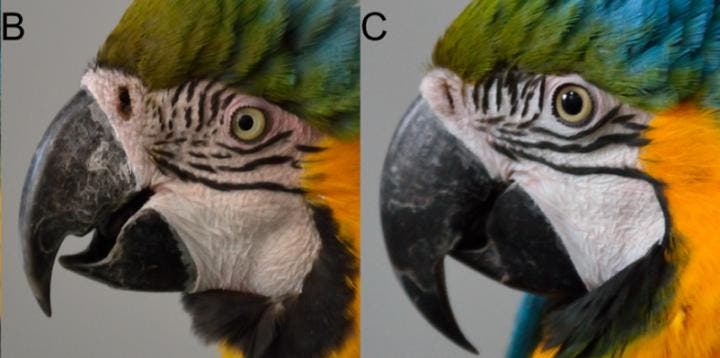Parrots, highly intelligent and communicative creatures, may employ an unexpected gesture to express themselves: blushing.

We used to once believe that complex communication was restricted to humans. But, time and time again, it’s been shown that other creatures are capable of conveying intricate messages, using a surprisingly wide array of tactics; simply put, we’re not nearly as unique as we once thought. Now, we can wipe yet another gesture from the “human only” list: blushing.
In a new study, five captive blue-and-yellow macaws (Ara ararauna) we’re examined while interacting with one another and their human caretakers. They noted the feather position (ruffled or sleeked) on the crown, nape, and cheek, as well as the presence or absence of blushing on the bare skin of the cheek.
They tried to figure out what these gestures meant, observing that feather ruffling was more common when the birds were not in motion, particularly during social interactions and resting periods. Meanwhile, blushing was much more common when the human caretaker was actively interacting with the parrot. This suggests that feather ruffling and blushing are associated with positive social interactions and may be used to communicate this feeling.
“How birds use facial displays and whether they communicate their inner subjective feelings is a question that is crucial to deepening our understanding of bird sentience,” Aline Bertin of the INRA Centre Val de Loire, France and colleagues write in the study.
“Blushing may not be a characteristic unique to humans: the featherless cheek of the blue-and-yellow macaw parrot reveals rapid skin color changes in situations associated with emotion. The macaw’s particularly complex face may enable communication of emotion via color and feather displays,” Bertin comments.
There is still some room for interpretation when it comes to the results, the team concedes. This was still a small sample size, and whenever you’re trying to discuss an animal’s subjective feelings, there will be some room for interpretation. But macaws (a generic name for New World parrots) have been shown to be highly intelligent, and are generally considered one of the smartest birds.
Aside from being a remarkable feature, this could also be significant for the welfare of the millions of parrots being kept as pets.
“On a practical level, parrots are popular companion animals, with millions of parrots being kept as pets, and understanding visual communication in parrots may help to assess their well-being in captive conditions,” Bertin concludes.
The article is freely available in PLoS ONE.
Bertin A, Beraud A, Lansade L, Blache M-C, Diot A, Mulot B, et al. (2018) Facial display and blushing: Means of visual communication in blue-and-yellow macaws (Ara Ararauna)? PLoS ONE 13(8): e0201762. https:/


